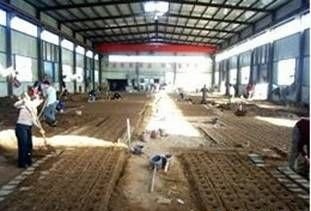At the eastern end of the New Eurasia Continental Landbridge, the Port of Lianyungang is one of China's first fourteen cities opened to foreign visitors and investments. The Port of Lianyungang is a growing center for industry, trade, and tourism.
In 1949, several river ports were merged and named Lianyungang. Facilities have been improved, and the Port of Lianyungang has continued to grow as a fishing port and center for the salt industry. China designated it as one of the "open" cities in its policy to encourage foreign investment.
Located in the middle of China's coast, the Port of Lianyungang is one of the ten largest seaports in China, and it has trade relationships with about a thousand ports in more than 150 countries around the world. The Port of Lianyungang works with than ten international container lines that make more than 160 voyages a month. The Port of Lianyungang is conveniently located near rail, road, and air transportation facilities.
In 2004, the Port of Lianyungang handled over 43 million tons of cargo and over 500 thousand containers. It has stock capacity for 3 million tons, over 110 acres of logistics park, and almost 25 acres of warehouse. It is China's largest port for importing alumina and for exporting wheat and veneer. It is the second largest port exporting coke.
The navigation channel to the Port of Lianyungang is dredged to 11.5 meters to accommodate vessels of up to 50 thousand DWT. The Port of Lianyungang covers one thousand hectares of working area and 30 square kilometers of water area. The port offers special-purpose docks for handling coal, containers, grain, wood, and some hazardous cargo.
The Port of Lianyungang has 24 berths. The bulk grain berth handles both imports and exports and can accommodate vessels to 35 thousand DWT. Two container berths and two timber berths can support vessels to 25 thousand DWT. Two general cargo berths can accommodate vessels to 15 thousand DWT.
The Port of Lianyungang contains 100 hectares of back yards with capacity to store 1.5 million tons of cargo at one time and capacity to turn over more than 15 million tons of cargo.
The Port of Lianyungang is currently implementing several projects to increase throughput capacity by five million tons and to lengthen the coastline by 500 meters. These include a 150-ton deep-water fairway, expansion of the MiaoLing Container Terminal, and construction of a 200-thousand-ton ore terminal and a 300-thousand-ton crude oil terminal. The goal is to exceed total throughput capacity of 100 million tons and three million containers.
The City of Lianyungang is also a popular tourist destination. It offers beautiful natural scenery with both mountains and sea nearby and is considered by many to be an ideal summer resort. Huaguo Mountain, home of the Monkey King, is located here, where visitors can enjoy a succession of beautiful waterfalls, the highest being over 100 feet. Travelers can also visit ancient Haizhou City, 5000-year old totem cave murals, the China's oldest Buddhist murals.
The Haizhou Bay Resort in the Port of Lianyungang contains the city's biggest beach and attracts thousands of visitors every year. The resort offers a variety of restaurants, shops, and entertainment events as well as several Qin Dynasty historic sites.
The Yuwan Natural Scenic Region is part of the Huagoushan Mountain Scenic Zone near the Port of Lianyungang. During the Qing Dynasty, the area was a fishing harbor and shelter. Today, it is a protected natural environment with waterfalls, natural ponds, caves, and springs where visitors can enjoy the natural beauty of southeastern China.
The Port of Lianyungang boasts the wonderful ten-kilometer long Qinshan Magic Path that stretches from Qinshan Island to the mainland. At low tide, the path is visible, but at high tide, much of it is submerged. Legend tells that the first Qin emperor, the Qinshihuang, paved the path with the wonderful white pebbles. The Qinshan Magic Path offers a wonderful area for swimming and exploring.
Xufu Village is the home of an official, Xu Fu, who worked for Emperor Qinshihuang. Xu Fu crossed the ocean in 219 AD searching for herbs that would make the emperor immortal; however, the party never returned. In Japan is a park and tomb bearing Xu Fu's name. Today, a temple and tombstone stand to honor the memory of this local hero.



No comments:
Post a Comment